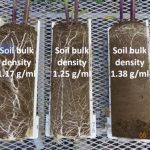Tag Archives Soil

Should soil organic matter be a factor in insurance premiums?
Research has found higher organic matter reduces drought impact

Opinion: Soil matters. Charting a path forward
Action is needed to preserve and improve soil health, but it must be strategic

Soil moisture more critical than rainfall to estimate climate impact
Science Notes: Evaporation, infiltration and runoff can result in dramatic differences

Making money through better soil and water management
Living Labs event features Kingsville-area farmer’s winning strategies

A new test for nitrogen on the horizon
New test being developed aims to better identify plant-available nitrogen

Soil freeze and thaw spike nitrous oxide emissions
Science Notes: Computer simulation aims to determine hotspots

Calculating soil health returns
Greenbelt report highlights costs and returns of soil-supporting management practices

Strip till a matter of helping the soil and lowering costs
Adoption rate is slow, but tools are available for growers to learn more

Making the case for low-pressure tires and waiting out the wet
Last fall’s harvest weather increased compaction risk

Evaluating soil structure
OMAFRA Field Crop Report for the week of August 15


